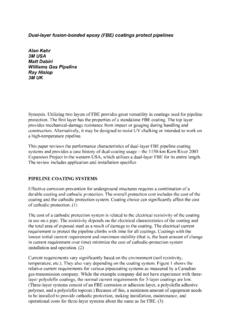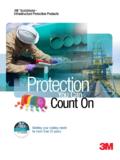Transcription of FBE, a Foundation for Pipeline Corrosion Coatings
1 FBE, a Foundation for Pipeline Corrosion CoatingsJ. Alan Kehr and David G. Enos3M CompanyCorrosion Protection Products Department6801 River Place , TXABSTRACTThe key to a successful Pipeline anti- Corrosion program is an effective protective coating systemcomprised of proven, high-quality coating materials, consistently applied to exacting specifications. Millapplied fusion-bonded epoxy (FBE) has been, and continues to be, the coating of choice for manypipeline operating companies since the 1960s. As the use of such Coatings has expanded, much researchhas been conducted in an effort to improve the physical, chemical, and economic aspects of thesecoatings. New advancements in FBE coating technology have led to the availability of dramaticallyimproved coating materials and systems to address specific Pipeline construction needs and to enable thecoating to function under a wide variety of corrosive conditions.
2 In this paper, a review of FBE pipecoatings will be presented, progressing from their early years to the next-generation materials underdevelopment today. FBE coating solutions for the Corrosion mitigation of Pipeline systems will bediscussed, ranging from its use as a stand-alone external coating , to the Foundation layer of a three-layercoating, to a stand alone internal : Fusion Bonded Epoxy, FBE, Pipe coating , Corrosion , Two-layer, Three-layer, internal lining,self-healing coatingINTRODUCTION FBE is dead. Long live FBE. 1 FBE Coatings have been in use for 40 years and, as such, areoften mistakenly viewed as an established, unchanging technology. This couldn t be farther from thetruth. FBE formulations of today are substantially different from their predecessors of even 5 years conditions into which coated pipelines are placed and performance expectations have2changed with time, often increasing in severity however, FBE Coatings have continuously evolved tomeet these new challenges.
3 The following sections will address the many applications of FBE in today spipeline industry (Figure 1), review its history as a Corrosion mitigation coating , and explore newdevelopments on the YESTERDAYA fusion-bonded epoxy is a one part, heat curable, thermosetting epoxy resin powder that utilizesheat to melt and adhere to a metal substrate. It provides a coating with excellent adhesion, a tough,smooth finish resistant to abrasion and chemical degradation, and with the absence of This combination of properties particularly the ease of use and chemical durability makeFBE an ideal choice as a protective coating under a wide variety of environmental conditions. As aresult, it is no coincidence that FBE Coatings have been used for Pipeline Corrosion mitigation since 1960on over one hundred thousand kilometers (sixty thousand miles) of coated pipe installed around the world(Figure 1).
4 FBE is not only used on pipelines. Though not the focus of this paper, FBE coated reinforcingsteel for concrete structures has been utilized since 1972 in over one hundred thousand concretestructures in North America costs an estimated three to four percent of gross national product for direct andindirect costs (Figure 2) in the developed countries of the In order to minimize such costs,selection of the most economically effective technique for mitigating the effects of Corrosion is a criticaldesign protection of pipelines, valves, and fittings from Corrosion is necessary to ensure long-termoperation, minimize maintenance, and to prevent costly service disruption, loss of life, and measures are extremely important.
5 Yet, they represent a small fraction of the overall cost of apipeline system. FBE Coatings offer a solution to the protection of a wide variety of components innumerous applications. This is why they are the cornerstone Corrosion protection defense in many gasand oil companies around the world. As will be seen FBE Coatings possess many properties, such as theability to optimize the benefits of cathodic protection (CP) at a defect site. This makes them a betterchoice than competitive systems such as 3-layer polyolefin tape Coatings for numerous Pipe coating :There are a number of performance factors to consider when selecting an external Pipeline coating5,6including: Physical and chemical stability Resistance to soil stress Adhesion and resistance to impact Resistance to cathodic disbondment FBE Coatings possess all of the aforementioned traits, a fact that leads to their frequent use forpipeline protection.
6 Fusion-bonded epoxy was first introduced by 3M Company for Pipeline corrosionprotection in 1960. Typically, Coatings have been single-coat materials applied in a thickness range of 300 m to 450 m (12 mils to 18 mils). To enhance specific properties, Pipeline owners occasionally specifyincreased coating thickness as much as 1000 m (40 mils). This thickness increase improves both high-3temperature cathodic disbondment and damage resistance. Significant performance improvements havealso been made over the years through advancements in formulation technology (Figure 3).In general, FBE standalone Coatings are an excellent choice when good construction andinstallation practices are in use, the backfill aggregate is controlled, and the operating temperature isbelow 65 C (150 F).
7 When the environmental requirements are demanding higher temperature or moreextreme installation circumstances dual and multilayer FBE systems are available. In other situations, athree-layer system consisting of an FBE base layer, an adhesive, and a thick polyolefin layer aresometimes specified. Although these systems possess increased damage tolerance and an extended high-temperature operating range, some researchers are concerned about their ability to interact effectivelywith cathodic protection. This will be discussed TODAYFBE as Single Layer coating :FBE Coatings are most commonly utilized as a monolithic Corrosion protection coating . Fusion-bonded-epoxy Coatings exhibit excellent adhesion to steel, have good chemical resistance, do not shieldthe pipe from cathodic protection, and there are no known cases of stress- Corrosion cracking (SCC) ofpipe coated with FBE has been installed under harsh conditions under the sea , through rollingplains, in rocky, mountainous areas, in the desert, and the arctic.
8 Although the coating is tough, wheninstallation damage occurs, it is readily detected and repaired. FBE coating systems have a good trackrecord of installation with a minimum of damage. When total damage and cost of repair are taken intoaccount, FBE may provide the best economic answer to field and construction damage (Figure 4). 8 Application of an FBE coating is straight forward, which is one of its greatest strengths. 9 As withmost other coating technologies, the surface to be coated is first cleaned, then grit blasted to provide anappropriate anchor pattern to enhance adhesion. Next, pipe being coated is heated to the applicationtemperature required to begin the coating process. Heating may be done in any number of ways,including induction, direct-flame impingement, and soaking ovens.
9 Once at temperature, the FBE isdeposited via an electrostatic spray process. The deposited powder then melts, and flows out over themetal surface resulting in a smooth, tough finish. The coating cures rapidly and is capable of supportingthe weight of the pipe within seconds of application. Once cured, the pipe is cooled for safe handling,inspected, and, if necessary, repaired (Figure 5). The resulting coated pipe is then ready for installationand use. Some of the advantages of this application method include the elimination of VOCs and the nearelimination of waste ( , overspray is readily recovered and recycled). In addition, this applicationtechnique is readily adapted for use in the field, through the use of portable application of FBE coating on girth welds (Figure 6) provides the same level of performancequality as plant-applied materials the Pipeline can be protected with the same coating from end to coating systems are also compatible with other girthweld repair systems 2-part liquid epoxies,shrinksleeves, and as Dual coating : Two-layer FBE systems utilize the application of a second coating on top of the base top layer typically is deposited during the melt (pre-gelation) stage of the primary layer.
10 The result isan intimate chemical bond between the two layers. A significant advantage of multilayer technology isthat unique characteristics can be developed by selection of different coating layers. Each layer can bedesigned to impart specific characteristics that combine to produce performance results that significantlyexceed those of a single coating . Examples are presented below:IMPACT RESISTANCE: A topcoat incorporating a closed-cell structure (Figure 7) that acts as animpact-energy absorber and imparts damage resistance to protect the primary Corrosion coating frompenetration and ensuing cathodic disbondment has been designed. Flexibility for field bending is alsomaintained. This system passes 3-layer specification requirements for impact RESISTANCE: Abrasion resistant dual-layer FBE systems make good choices when pipewill be installed via directional boring, or if there is likelihood of rough construction practices orinstallation in rugged terrain.


